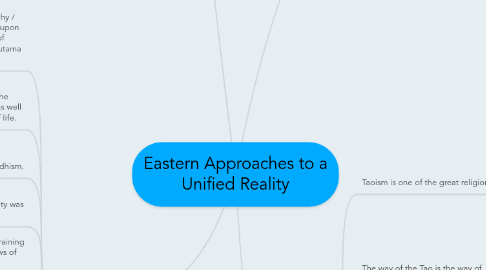
1. Buddhism
1.1. Moral philosophy / religion based upon the teachings of Siddhartha Gautama (Buddha)
1.1.1. Buddha means : "one who has awakened"
1.2. Metaphysical knowledge into the nature of reality as well as a moral way of life.
1.3. The Middle Way is an important idea in Buddhism.
1.3.1. Seeks moderation and avoid the extremes of self-indulgence and self-mortification
1.4. Buddha taught that nature of reality was impermanent and interconnected
1.5. Liberation from suffering may come by training the mind and acting according to the laws of karma (cause and effect).
1.5.1. With right action, good things will come to you
1.6. Four Noble Truths :
1.6.1. Dukkha : Suffering is everywhere
1.6.2. Samudaya : There is a cause of suffering
1.6.3. Nirodha: There is an end of suffering
1.6.4. Maggo: There is a path that leads out of suffering
1.7. "I will teach you the Truth and the Path leading to the Truth" (Buddha)
1.8. Nature of Reality
1.8.1. Believe that truth is what governs the human life and the world
1.9. Mind over Matter
1.9.1. There is only existence in particles and in states of consciousness.
1.10. Meaning of Life
1.10.1. To reach the end of human suffering
1.10.2. To be released from the endless cycle of birth
2. Confucianism
2.1. Five virtues: charity, justice, propriety, wisdom, and loyalty.
2.2. Teachings of the Chinese sage, Confucius.
2.2.1. Confucius was a famous thinker and social philosopher of China, whose teachings have deeply influenced East Asia for centuries.
2.3. Ethical-sociopolitical teachings" sometimes described as a religion
2.3.1. Five virtues: charity, justice, propriety, wisdom, and loyalty
2.4. His philosophy emphasized personal and governmental morality, correctness of social relationships, and justice and sincerity.
2.5. “ Respect yourself and others will respect you.”
2.6. What is self?
2.6.1. Everyone is born in four beginnings
2.6.1.1. Poverty
2.6.1.2. Wisdom
2.6.1.3. Compassion
2.6.1.4. Righteousness
2.7. The meaning of life
2.7.1. The meaning of life is found through moral education and wisdom
2.8. Nature of Reality
2.8.1. Moral Law
3. Hinduism
3.1. Started to develop between 500 BCE and 300 CE
3.1.1. Found most notably in India and Nepal
3.2. Hindus believe that all living creatures have a soul
3.2.1. The soul is believed to be eternal
3.3. Hindu psychology recognized three states of mind
3.3.1. the unconscious or the subconscious
3.3.2. the conscious
3.3.3. the superconscious
3.4. A pure mind alone can have super-conscious experience or the experience of Samadhi
3.4.1. Ordinary mind is like ice or water.
3.4.2. Due to its limitations it cannot have super-conscious experience
3.4.3. Unconscious state of mind as a storehouse of all past thoughts
3.5. According to Hinduism, the meaning (purpose) of life is four-fold: to achieve Dharma.
3.5.1. Dharma means : to act virtuously and righteously
3.5.1.1. Which means to act morally and ethically throughout one’s life
3.6. What is self?
3.6.1. Anyone is enternal
3.7. Nature of Reality
3.7.1. The life cycle goes : birth, death, re-birth as with karma as the influencer
4. Taoism
4.1. Taoism is one of the great religions.
4.2. The way of the Tao is the way of Nature and of ultimate reality.
4.2.1. Tao can be defined as 'path', or 'road'
4.2.2. Often described as a force that flows through all life.
4.2.3. A happy and virtuous life is one that is in harmony with the Tao, with Nature.
4.3. "Hold on to the Tao of old in order to master the things of the present.”
4.4. What is self?
4.4.1. One must move into the environment as a whole, or there is no self.
4.5. The meaning of life
4.5.1. To discover the nature of being and existing.
4.6. The Nature of Reality
4.6.1. The nature of life is the Tao.
4.7. Mind over Matter
4.7.1. There are small opposite corespondents within every living thing

